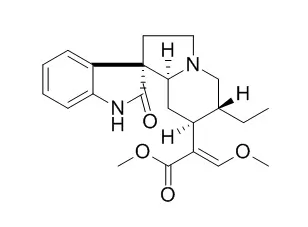| Description: |
Isorhynchophylline exerts anti-inflammatory, anticancer and anti-metastatic effects, it exerts neuroprotective effect against Aβ 25-35-induced neurotoxicity in vitro via PI3K/Akt signaling pathway. Isorhynchophylline shows antidepressant-like effects, which are mediated, at least in part, by the inhibition of monoamine oxidases. Isorhynchophylline plays a remarkably preventive role in cardiac arrhythmias through the inhibition of calcium currents in rats and guinea pigs; it also shows inhibition on angiotensin II-induced proliferation in rat vascular smooth muscle cells.
|
| In vitro: |
| Int J Mol Sci. 2017 May 19;18(5). | | Isorhynchophylline, a Potent Plant Alkaloid, Induces Apoptotic and Anti-Metastatic Effects in Human Hepatocellular Carcinoma Cells through the Modulation of Diverse Cell Signaling Cascades.[Pubmed: 28534824] | Isorhynchophylline (Rhy) is an active pharmacological component of Uncaria rhynchophylla that has been reported previously to exert significant antihypertensive and neuroprotective effects. However, very little is known about its potential anti-cancer activities.
METHODS AND RESULTS:
This study was carried out to evaluate the anticancer effects of Rhy against various human carcinoma cell lines. We found that Rhy exhibited substantial cytotoxic effect against human hepatocellular carcinoma HepG2 cells when compared with other human carcinoma cell lines including those of lung, pancreas, prostate, head and neck, breast, multiple myeloma, brain and renal cell carcinoma. Rhy induced apoptosis as characterized by accumulation of cells in sub G1 phase; positive Annexin V binding; activation of caspase-8, -9, and -3; and cleavage of PARP (poly-ADP ribose polymerase). This effect of Rhy correlated with the down-regulation of various proteins that mediated cell proliferation, cell survival, metastasis, and angiogenesis. Moreover, cell proliferation, migration, and constitutive CXCR4 (C-X-C chemokine receptor type 4), MMP-9 (Matrix metallopeptidase-9), and MMP-2 expression were inhibited upon Rhy treatment. We further investigated the effect of Rhy on the oncogenic cell signaling cascades through phospho-kinase array profiling assay. Rhy was found to abrogate phospho-p38, ERK, JNK, CREB, c-Jun, Akt, and STAT3 signals, but interestingly enhanced phospho-p53 signal.
CONCLUSIONS:
Overall, our results indicate, for the first time, that Rhy could exert anticancer and anti-metastatic effects through regulation of multiple signaling cascades in hepatocellular carcinoma cells. | | Evid Based Complement Alternat Med. 2013;2013:163057. | | Isorhynchophylline Protects PC12 Cells Against Beta-Amyloid-Induced Apoptosis via PI3K/Akt Signaling Pathway.[Reference: WebLink] | The neurotoxicity of amyloid- β (A β ) has been implicated as a critical cause of Alzheimer's disease. Isorhynchophylline (IRN), an oxindole alkaloid isolated from Uncaria rhynchophylla, exerts neuroprotective effect against Aβ 25-35-induced neurotoxicity in vitro. However, the exact mechanism for its neuroprotective effect is not well understood.
METHODS AND RESULTS:
The present study aimed to investigate the molecular mechanisms underlying the protective action of IRN against Aβ 25-35-induced neurotoxicity in cultured rat pheochromocytoma (PC12) cells. These experimental findings unambiguously suggested that the protective effect of IRN against Aβ 25-35-induced apoptosis in PC12 cells was associated with the enhancement of p-CREB expression via PI3K/Akt/GSK-3 β signaling pathway. |
|
| In vivo: |
| Neurochem Res. 2017 Feb;42(2):678-85. | | Antidepressant-Like Effect of Isorhynchophylline in Mice.[Pubmed: 27900600 ] | Isorhynchophylline (IRN), an oxindole alkaloid, has been identified as the main active ingredient responsible for the biological activities of Uncaria rhynchophylla (Miq) Miq ex Havil. (Rubiaceae).
Previous studies in our laboratory have revealed that IRN possesses potent neuroprotective effects in different models of Alzheimer's disease. However, the antidepressant-like effects of IRN are remained unclear.
METHODS AND RESULTS:
The present study aims to evaluate the antidepressant-like effects of IRN. The antidepressant-like effects of IRN was determined by using animal models of depression including forced swimming and tail suspension tests. The acting mechanism was explored by determining the effect of IRN on the levels of monoamine neurotransmitters and the activities of monoamine oxidases. Intragastric administration of IRN at 10, 20 and 40 mg/kg for 7 days caused a significant reduction of immobility time in both forced swimming and tail suspension tests, while IRN did not stimulate locomotor activity in the open-field test. In addition, IRN treatment antagonized reserpine-induced ptosis and significantly enhanced the levels of monoamine neurotransmitters including norepinephrine (NE) and 5-hydroxytryptamine (5-HT), and the activity of monoamine oxidase A (MAO-A) in the hippocampus and frontal cortex of mice.
CONCLUSIONS:
These results suggest that the antidepressant-like effects of IRN are mediated, at least in part, by the inhibition of monoamine oxidases. | | Planta Med. 2011 Sep;77(13):1477-81 | | Protective effects of isorhynchophylline on cardiac arrhythmias in rats and guinea pigs.[Pubmed: 21294075 ] | As one important constituent extracted from a traditional Chinese medicine, Uncaria Rhynchophylla Miq Jacks, Isorhynchophylline has been used to treat hypertension, epilepsy, headache, and other illnesses. Whether Isorhynchophylline protects hearts against cardiac arrhythmias is still incompletely investigated.
METHODS AND RESULTS:
This study was therefore aimed to examine the preventive effects of Isorhynchophylline on heart arrhythmias in guinea pigs and rats and then explore their electrophysiological mechanisms. In vivo, ouabain and calcium chloride were used to establish experimental arrhythmic models in guinea pigs and rats. In vitro, the whole-cell patch-lamp technique was used to study the effect of Isorhynchophylline on action potential duration and calcium channels in acutely isolated guinea pig and rat cardiomyocytes. The dose of ouabain required to induce cardiac arrhythmias was much larger in guinea pigs administered with Isorhynchophylline. Additionally, the onset time of cardiac arrhythmias induced by calcium chloride was prolonged, and the duration was shortened in rats pretreated with Isorhynchophylline. The further study showed that Isorhynchophylline could significantly decrease action potential duration and inhibit calcium currents in isolated guinea pig and rat cardiomyocytes in a dose-dependent manner.
CONCLUSIONS:
In summary, Isorhynchophylline played a remarkably preventive role in cardiac arrhythmias through the inhibition of calcium currents in rats and guinea pigs. |
|






 Cell. 2018 Jan 11;172(1-2):249-261.e12. doi: 10.1016/j.cell.2017.12.019.IF=36.216(2019)
Cell. 2018 Jan 11;172(1-2):249-261.e12. doi: 10.1016/j.cell.2017.12.019.IF=36.216(2019) Cell Metab. 2020 Mar 3;31(3):534-548.e5. doi: 10.1016/j.cmet.2020.01.002.IF=22.415(2019)
Cell Metab. 2020 Mar 3;31(3):534-548.e5. doi: 10.1016/j.cmet.2020.01.002.IF=22.415(2019) Mol Cell. 2017 Nov 16;68(4):673-685.e6. doi: 10.1016/j.molcel.2017.10.022.IF=14.548(2019)
Mol Cell. 2017 Nov 16;68(4):673-685.e6. doi: 10.1016/j.molcel.2017.10.022.IF=14.548(2019)